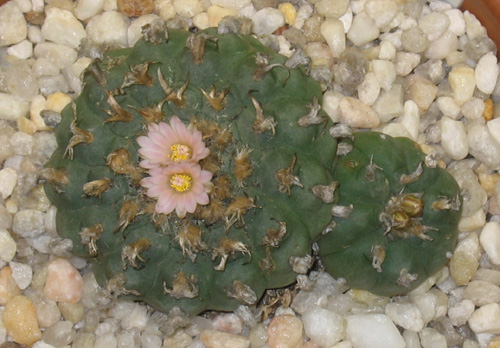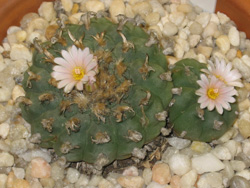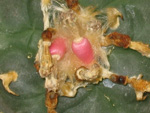|
History of Lophophora
Lophophora has
had one of the oldest, most colourful and convoluted backgrounds
of any plant, most likely due to its mescaline carrying properties.
In fact, it seems that recent radio carbon dating (October 2005)
on two individual samples (dated to the calendric time
interval of around 3780-3660 BC) have made Lophophora
the oldest
known useable plant we have going. These samples were
originally collected
by Native Americans in the Rio Grande area due to there
mescaline carrying properties, and were found in the Shumla
Caves of Texas.
To begin, it wasn’t until 1638 that Hernandez the naturalist
of Philip II of Spain gave Lophophora its first proper botanical
description and
named it “Peyoti Zacatensis”. Then in 1845
the French botanist Charles Lamaire became
the first person to publish a botanical name for peyote and called
it “Echinocactus Williamsii”,
which appeared without picture or description in a horticultural
magazine. By 1847 though, the first picture of peyote appeared
in Curtis’ Botanical Magazine as
shown in Image 1.

Image 1 -
The first illustration of peyote
appeared in Curtis's Botanical Magazine
in 1847 (plate 4296).
In 1872, S. Voss changed the classification of peyote
to “Anhalonium Williamsii”. Then, by
1891 an American botanist by the name of John
Coulter transferred peyote to the genus Mammillaria,
only to have S.Voss confuse things once again in 1894 when
he placed peyote in the genus Ariocarpus. Thankfully
though, later in the year of 1894 John Coulter did a
taxonomic study on peyote and described it as the genus Lophophora,
the name from the Greek lophos, crest, and phoreus, bearer, thus
crest bearer, referring to the crests or tufts of hairs borne
on each tubercle.
Further down the page is a Timeline adaptation
of the History of Lophophora Williamsii for those that need to
know more than was offered in this condensed version above.
Historical
Usage of Lophophora Williamsii
Present day studies and records show that
peyote has been collected and used by the indigenous people
of North America ever since the years 3780-3660 BC.
Most prevalent would be the use of peyote for ceremonial
purposes by Native Americans. Once consumed, peyote is
used as a means of communicating with the spirit world.
The Tarahumara (one of two original indigenous
tribes that actually still go on pilgrimages for peyote) are famous
as great distance runners. These athletes/hunters run barefoot
and naked except for loin cloths and little pouches containing
peyote at their sides. Each athlete eats peyote as he runs
to combat pain, attain greater endurance and combat hunger and
thirst while hunting for days without food, water, or rest.
Furthermore, tribes such as the Tarahumara and Huichol Indians drink
powdered peyote in water to give health, long life and to purify
body and soul. They also apply it externally
after chewing to treat snakebite, bruises, wounds, burns, fractures,
constipation, and use it as an analgesic, anti-rheumatic, and
general tonic
.
As traditional medicine, peyote has also been shown
to have antibiotic activity against a wide variety of bacteria including some
penicillin resistant strains. Beyond this, peyote has been used
in the treatment of arthritis, consumption, influenza, intestinal disorders,
diabetes, scorpion bites, datura poisoning, to combat painful joints, toothache,
pain in child-birth, fever, breast pain, skin disease, diabetes, colds, blindness,
neurasthenia, hysteria and asthma. And if all this isn’t enough for
you, the flesh of peyote may also be applied topically to promote milk
production.
As for threats to peyote, most typically the worst
are that of mealy bug, and spider mite infestations.
Lophophora has an even bigger problem in that of fighting the
US government’s movement to make the little plant extinct. It
seems governments do not like anything that
they are not collecting taxes for, but they seem to dislike anything
that might be considered a narcotic even more. Luckily we don’t
have this problem in Canada but at the same time we do not have
the climate to grow peyote outdoors year round either. So the
next biggest problem is that of excessive root plowing and
the wipe out of useable habitat to make room for people.
Historical Timeline
3700 BCE - Native Americans in
the Rio Grande (Shumla Caves) area collected mescaline containing
peyote buttons.
1000 BCE - Peyote used ceremonially by indigenous cultures in Texas
and Mexico.
Jun 15, 1521 - The use of hallucinogenic mushrooms and peyote are
driven underground as use of "non-alcohol" intoxicants
is forbidden by Europeans in Mexico. Catholic priests punish the
use of entheogens by native people.
100BC to 200AD - Funerary art from the Colima culture. The
earliest images of cacti are of those with hallucinogenic properties:
Echinopsis Pachanoi from Peru (c.1300BC) and Lophophora species
in Mexico dating back to around 300BC.
1560 – Spanish priest Bernardino de Sahagún writes
in his Florentine Codex about the use of peyote and hallucinogenic mushrooms
by the Chichimeca Indians of Mexico. He called it Peyotl and estimates
it has been in use since at least 300 B.C. due to evidence found
in a snuffing pipe from the Monte Alban culture.
1550 – 1750 - Determined effort by Spaniards to stamp out peyote
practices amongst native Mexicans. Peyote use is denounced by European
Catholics as an act of witchcraft and superstition because it was
for "purposes of detecting thefts, of divining other happenings
and foretelling future events." Its use was equated with cannibalism
in some catholic texts.
The first manuscript reference to the peyote
cactus was in a report
of the Franciscan friar Bernardino de Sahagun in his Historia general
de las cosas de Nuevo Espana (general history of the things of
new Spain), but not formally published until 1829.
1591 - Probably the most important early medical
description of the effects of peyote is that of the physician Juan
de Cardenas, whose work was published in Mexico in 1591 under
the title Problemas y secretos maravillosos de las indias (Problems
and Miracle secrets of the Indians).
1638 - The first proper botanical description of Peyote is made
by Hernandez, the naturalist of Philip II of Spain. Gave
peyote its first name “Peyoti zacatensis”.
1760 - There is some evidence that the use of peyote has spread
into the United States.
1845- Apparently the French botanist Charles
Lemaire was
the first person to publish a botanical name for
peyote, but unfortunately the name that Lemaire used for the plant, Echinocactus
Williamsii appeared without description
and only in a horticultural catalog. Therefore, it was necessary
for Prince Salm-Dyck, another European botanist,
to provide the necessary description to botanically validate Lemaire's
binomial. No illustration accompanied either the Lemaire name or
the description by Salm-Dyck.
1847 - The first picture of peyote appeared
in Curtis' Botanical Magazine (See Image 1 above).
1870s - Peyote use spreads more widely into the
United States.
1872 - Peyote classification changed to Anhalonium
Williamsii by
Voss.
1886 - Theodore Rumpler proposed
that peyote be removed from Echinocactus and placed in the
new segregate genus Anhalonium, thus
making the binomial A. Williamsii, a name which soon became widely
used throughout Europe and the U.S.
1887 - Dried Peyote buttons are distributed by Parke Davis & Co.
1888 - Botanist Paul Hennings published a report on Lophophora chemistry, leading
to further investigations by other botanists.
Late 1800s - North American Indians brought back knowledge of Peyote from raids
on Mexico. Along with another contemporary movement, the Ghost Dance, Peyote
use spread quickly among the Indian tribes of America. Indian prophets like Quanah
Parker added Christianity to traditional beliefs and formed the basis of the
Peyote ritual practiced most commonly today by the Native American Church.
1890s - The German chemist Arthur Heffter received a shipment
of poorly documented and incorrectly identified peyote specimens for laboratory
analysis. These plants were to be the basis of some of the most important, and
confusing pioneer chemical studies of peyote. Heffter discovered that the plants
he had received belonged to two distinct groups based on the alkaloids present
but he claimed that he was unable to distinguish the groups on structural or
morphological grounds. Since he had no collection and field data he decided that
peyote simply consisted of two chemical forms. Jan G. Bruhn of the University
of Uppsala and Bo Holmstedt of the Swedish Medical Research Council have thoroughly
researched the literature dealing with this period of peyote history; their conclusion
is that Heffter's batch of plants actually consisted of the two distinct
species of peyote, which do have definite alkaloid differences. A better
botanical understanding of the group, as well as proper scientific data, would
have prevented the introduction of much confusing information into the literature
that has persisted for more than seventy-five years.
1891 - Additional confusion concerning the botanical classification of peyote
occurred when the American botanist John Coulter transferred
peyote to Mammillaria, a genus commonly called
the pincushion or nipple cactus.
1892 - German explorer Lumhotz described ceremonial Peyote use among the Huichol
and Tarahumara, and sent samples of the cacti to Harvard for Botanical analysis.
1894 - A European named S. Voss confused things once again by
placing peyote in Ariocarpus, the valid name
for a distinct, and quite different group of plants that had been also called Anhalonium.
1894- John Coulter did a taxonomic
study on peyote and described it as the genus Lophophora, the name from the Greek
lophos, crest, and phoreus, bearer, thus crest bearer, referring to the crests
or tufts of hairs borne on each tubercle. This helped clarify the nomenclatural
situation because peyote had been included in at least five different genera
of cacti by the end of the nineteenth century. The group of plants commonly called
and used as peyote is unique within the cactus family and deserves separation
as the distinct genus Lophophora.
1896 Dec. - Two early experience reports describing the effects of a peyote
extract are published in The British Medical Journal.
1897 - Nov 23, Mescaline is first isolated and identified by German chemist Arthur
Heffter.
1902 - An early article on peyote titled "Mescal: A Study of a Divine Plant" is
published in Popular Science Monthly.
1918 - The Native American Church is formed. James Mooney, a Smithsonian Institute
archaeologist who traveled through Oklahoma in 1891 participating in various Peyote
ceremonies, became convinced of the need to unite the Indians and protect their
legal right to worship with Peyote. He called together meeting of all of the
great roadmen in 1918 where he wrote the charter for and incorporated the Native
American Church.
1919 - Mescaline is first synthesized by Ernst Spath.
1922 - An estimated 13,000-22,000 ceremonial users of Peyote in the U.S.
1927 - An extensive study of mescaline's effects was published in Der Meskalinrausch
(The Mescaline High).
1930 - Over a dozen states had outlawed possession of
Peyote, largely as an anti Native American statement.
1944 – Lophophora Echinata var. Diffusa was validly published
by Croizat
1945 Oct. - US Navy Technical Mission reports on mescaline experiments at
the Nazi Dachau concentration camp.
1947 - U.S. Navy initiates mescaline studies under the auspices of 'Project Chatter'.
1952 - Dr. Humphry Osmond begins working with hallucinogens at a hospital in
Saskatchewan, looking at the similarity between mescaline and the adrenaline
molecule.
1953 – In May, Aldous Huxley tries mescaline (400 mg) for the first time under
the supervision of Dr. Humphrey Osmond. During the experience, he commented "This
is how one ought to see, how things really are."
1954 - The Doors of Perception by
Aldous Huxley is published describing
his 1953 experience with mescaline.
1960 - Arizona Judge Yale McFate rules that Native Americans are guaranteed access
to the Peyote sacrament under the First and Fourteenth amendments.
1967 - Peyote is banned federally in the U.S.
1967 - H.H.Bravo found near Queretaro in south-central Mexico
another species which he named L.Diffusa. This plant is yellow-green, soft, and
ribless and contains a somewhat different alkaloid mixture with far less mescaline
if any at all than L.Williamsii.
1970 Oct 27, - The Comprehensive Drug Abuse Prevention and Control Act is passed.
Part II of this is the Controlled Substance Act (CSA) which defines a scheduling
system for drugs. It places most of the known hallucinogens (LSD, psilocybin,
psilocin, mescaline, peyote, cannabis, & MDA) in Schedule I. It places coca,
cocaine and injectable methamphetamine in Schedule II. Other amphetamines and
stimulants, including non-injectable methamphetamine are placed in Schedule III.
1991 - Alexander and Ann Shulgin publish PiHKAL, documenting over 250 phenethylamines,
including MDMA, mescaline, 2C-B, 2C-T-7, 2C-T-2, and many others.
2005 - The abstract below was retrieved from Pubmed,
a part of the National Center for Biotechnology Information (NCBI):
Title: "Prehistoric peyote use: alkaloid analysis and radiocarbon
dating of archaeological specimens of Lophophora from Texas." J
Ethnopharmacol. 2005
Oct 3;101(1-3):238-42. Two archaeological specimens of peyote buttons,
i.e. dried tops of the cactus Lophophora Williamsii (Lem.) Coulter, from the
collection of the Witte Museum in San Antonio, was subjected to radiocarbon dating
and alkaloid analysis. The samples were presumably found in Shumla Cave No. 5
on the Rio Grande, Texas. Radiocarbon dating shows that the
calibrated 14C age of the weighted mean of the two individual dated samples corresponds
to the calendric time interval 3780-3660 BC (one sigma significance).
Alkaloid extraction yielded approximately 2% of alkaloids. Analysis with thin-layer
chromatography (TLC) and gas chromatography-mass spectrometry (GC-MS) led to
the identification of mescaline in both samples. No other peyote alkaloids could
be identified. The two peyote samples appear to be the oldest plant drug
ever to yield a major bioactive compound upon chemical analysis. The
identification of mescaline strengthens the evidence that native North Americans
recognized the psychotropic properties of peyote as long as 5700 years
ago.

email: dr_frank @ magicactus.com
Mailing
address:
Frank
Valente
MagiCactus.com
56 Dewhurst Blvd.
Toronto, Ontario
M4J 3J3
© 2008, Frank Valente |


